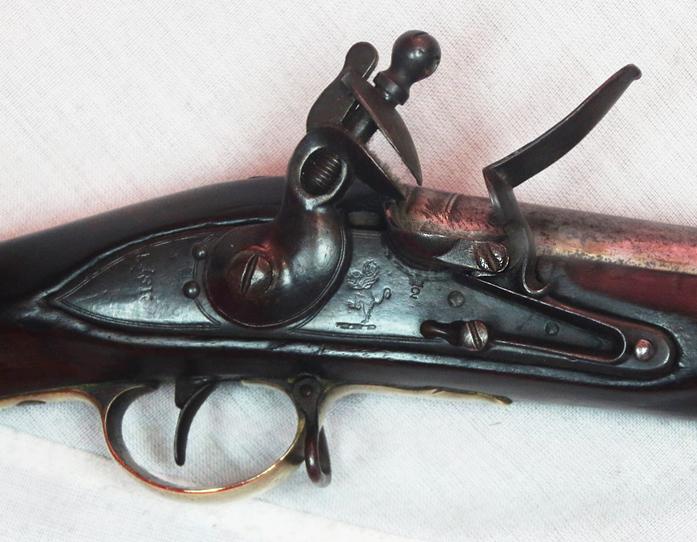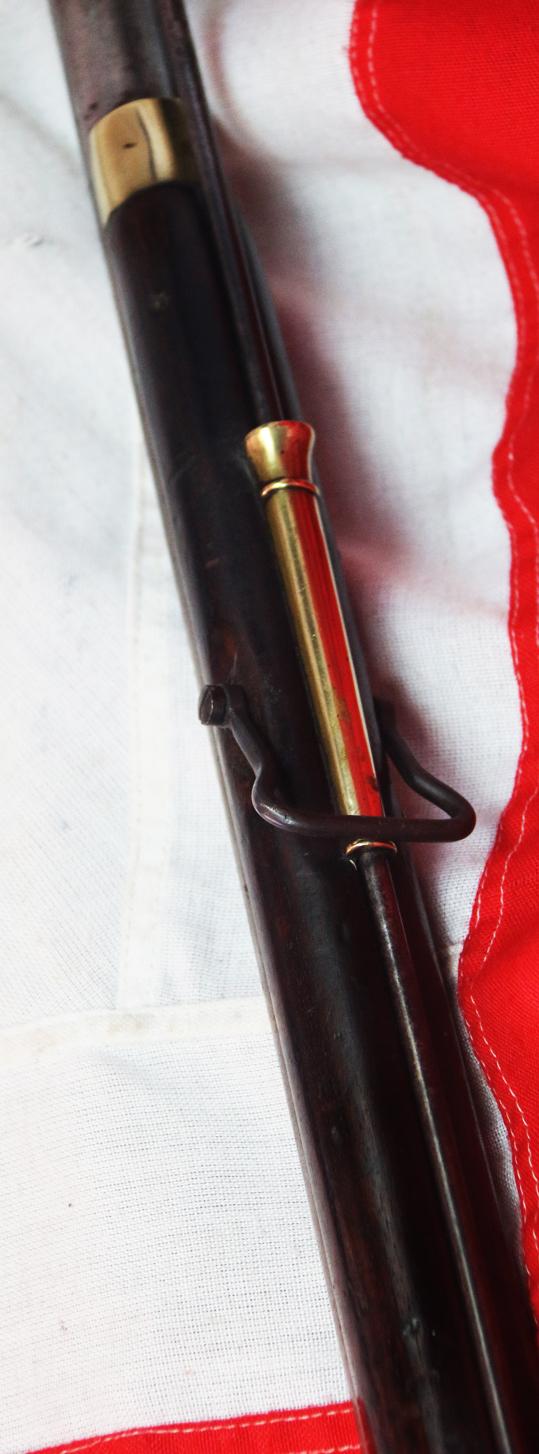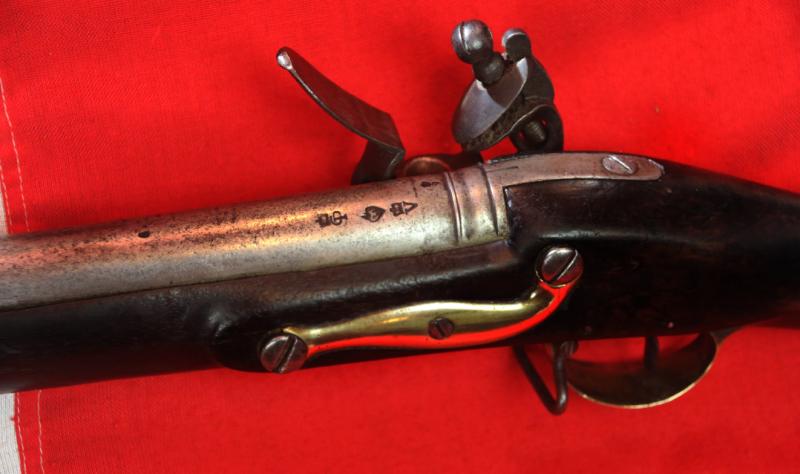A Very Fine British ‘Brown Bess’ India Pattern Infantry Musket, Of The Napoleonic Wars Period, Circa 1810. For Over One Hundred Years The British ‘Brown Bess’ Was The Most Famed and Feared Musket In The World. No Army In The World Failed To Respect Them
Facing a volley of several hundred or even thousands of them, fired in the enemies direction, repeated every few seconds, must have been a terrifying experience, never to be forgotten should they, by sheer luck, survive their awesome power. A demonstration of fire power that it could only be compared to, was British Artillery cannon fire.
In superb condition for age. The lock bears the ordnance ‘crown 2’ inspection stamp of Richard Duce {Crown Inspector from 1797 to 1818} universally seen on the muskets given over to the British ordnance for issue for line regiments in the Napoleonic Wars.
One of the India Pattern muskets likely turned over by the East India Co. army to the Board of Ordnance during the Napoleonic wars, due to the urgent need for arms to counter Napoleon's massive armament reserve. The musket was the standard weapon issued to the British soldier throughout the 18th and early-19th centuries. It would be the India Pattern musket that would play a central and pivotal role in the wars against Revolutionary and Napoleonic France.
By the end of the American Revolutionary War in 1783, the British Army was armed with the Pattern 1777 Long Land and Pattern 1779(S) Short Land musket. The ‘short land’ was a musket made to the strict quality guidelines of the Board of Ordnance, and was characterised by its 42 in barrel. After the war the expectation was for a period of peace, a time when the need for Ordnance materials would be low, so the standing contracts for the Pattern 1777 and the Pattern 1779(S) musket were cancelled. Parliament was not prepared to fund equipment it deemed unnecessary, so financial retrenchment was the order of the day. Parliament is consistent in it repeated inclination to repeat over and over again its failure to grasp the realities of the most painful of lessons from history. Never being prepared for war makes it near inevitable, and being constantly prepared for war, ironically, makes it far less likely. The fundamental tenet of invasion and conquest, like bullying in the school playground is the same; the little unarmed guy gets crushed, the big, well protected guy, respected.
The world changed in 1793, a mere 10 years after the loss of the American colonies. Britain found itself once again at war, this time with Revolutionary France. An army now reduced in size to an authorized strength of only 44,432 men had to be expanded rapidly, along with the local militia and volunteer forces. The call for muskets was huge. Indeed, in 1793 the total stock of muskets in armouries around Britain, including the central arsenal at the Tower of London, was around 60,000. The stocks held in French arsenals amounted to over 700,000.
Something needed to be done. At first the Board of Ordnance tried to ramp up production of the Short Land Pattern muskets by engaging new contractors. Yet despite producing over 31,000 muskets in 1793 the numbers were still woefully inadequate for the expanding forces.
The Board of Ordnance had to fill the gap. They did this by ordering 10,000 muskets from the Birmingham gun trade and 10,000 from their usual emergency suppliers in Liege, Belgium. However this was still not enough, especially as the private contractors in both Birmingham and London were hard at work fulfilling orders for the private trade and for the East India Company, one of the biggest private purchasers of military arms. To begin to solve this lack of supply the Master General of the Ordnance, the Duke of Richmond, suggested to the government that they persuade the East India Company to sell their stocks of muskets to the government and also to agree not to place any further orders until the Ordnance's requirements were met.
The duke wrote to the Home Secretary, Henry Dundas, on the matter. As Chairman of the Board of Control of the East India Company Dundas had earlier been instrumental in securing parliamentary approval for the renewal of the East India Company's monopoly. The duke stated that he was: 'aware how unpleasant it must be to take such a step, and to deliver out to our troops these East India Company muskets, but ... the least important must give way to the most; and you will be best able to judge whether the East India Company can admit of a delay in respect of theses arms. And altho' they might not be quite so perfect as ours, they undoubtedly must be serviceable ones, and such as the new Raised Corps must put up with on the current Emergency.'
This suggestion was met with agreement, and the idea of introducing the East India Company's arms into British Army service was conceived. By the end of 1794 the East India Company had delivered 29,920 muskets into government stores, all that they could spare. Indeed transactions for East India Company muskets would continue throughout the duration of the Revolutionary and Napoleonic wars. By 1815, the East India Company had sold the Board of Ordnance at least 142,970 small arms.
The musket that the East India Company supplied was one originally designed by General Lawrence for East India Company service, altered and simplified by Lieutenant Colonel Edward Windus in 1771. The musket in Company service became known as the 'Windus' pattern. In 1795, the Board of Ordnance began to order 'India Pattern' muskets on its own account and by 1797 it officially adopted the musket as the Model 1793 and began to place substantial orders for it with the Birmingham gun trade.
The Model 1793 India Pattern musket was standardized by the Board of Ordnance in 1797, taking account of its comparable cheapness, simplicity of design and ease of manufacture. By the end of 1797, the Birmingham gun trade was able to deliver some 72,000 muskets to the government proof house at Bagot Street. The success of this model was self evident, along with its slightly modified successor the Model 1809 India Pattern. They produced at an average price of 18 shillings and 5 pence (roughly £3,000 in today's money).
The Brown Bess musket was the standard weapon of the British infantry for more than a century. Soldiers on both sides of the War of 1812 employed it in battle, staring down its barrel at opponents across distances of less than a hundred yards.
Flintlock musket
The Brown Bess musket was the standard weapon of the British for more than a century.
British foot soldiers marched into battle with this musket—nicknamed “Brown Bess”—for more than 100 years. British redcoats used the Brown Bess to fight the War of Independence in the colonies, and many of their opponents in the Americans’ Continental army used it as well. British soldiers fighting in the Napoleonic wars carried it into battle, and it was the principal firearm used by the infantrymen who fought the War of 1812.
The Brown Bess had several distinctive features. It was a large-calibre weapon: the bullet it fired was a lead ball up to three-quarters of an inch in diameter, three times the diameter of a modern .22-caliber rifle round. The inside of its barrel was smooth: unlike more accurate “rifled” muskets used by the famous rifle regiments, the Brown Bess had a smooth bore with no grooves to make its fire more accurate. Soldiers loaded the musket through the muzzle, which meant that each bullet had to be forced down a longer than three foot barrel before firing. Even trained soldiers could only launch two or three shots per minute.
Because the weapon was slow to load and relatively inaccurate (experienced soldiers generally estimated its range between 50 and 100 yards), armies developed tactics that helped compensate for its shortcomings. The limitations of smoothbore muskets like the Brown Bess forced units employ “linear tactics,” in which a hundreds of soldiers stood in neat lines, shoulder-to-shoulder and out in the open. While such tactics appear decidedly unstealthy to twenty-first century eyes, they proved essential on the battlefields of all the conflicts which Britain was involved.
There, stealth was a low priority. Packing the men into blocs allowed officers to coordinate their troops’ fire into synchronized volleys. Firing a hundred guns in the same direction at once helped ensure that at least some, often most of the inaccurate musket balls found their targets. And grouping the men into neat lines out in the open helped commanders ensure that few of their troops gave in to the natural instinct to flee.
Of course, packing troops into blocks and fighting in the open required tremendous discipline from the individual soldiers. Infantrymen had to stand exposed to enemy fire as they loaded and fired their own muskets. And in some situations, soldiers learned the grisly dangers of fighting in lines—as at the Battle of New Orleans in the 1812 war, where American artillery attacked the exposed British formations with devastating effect.
The last photo in the gallery shows a photograph of one section of the collection in the museum of Waterloo, taken in around 1900, showing all the weapons of Waterloo en situ, including all the protagonists {British, French, Prussian and Belgian muskets, swords, pistols, armour uniforms, etc}. The museum was founded and owned by a veteran of the 7th Hussars that fought.
Overall in super condition, signs of combat use as to be expected, with some small carved military marking to the butt stock
Code: 25208
3450.00 GBP










